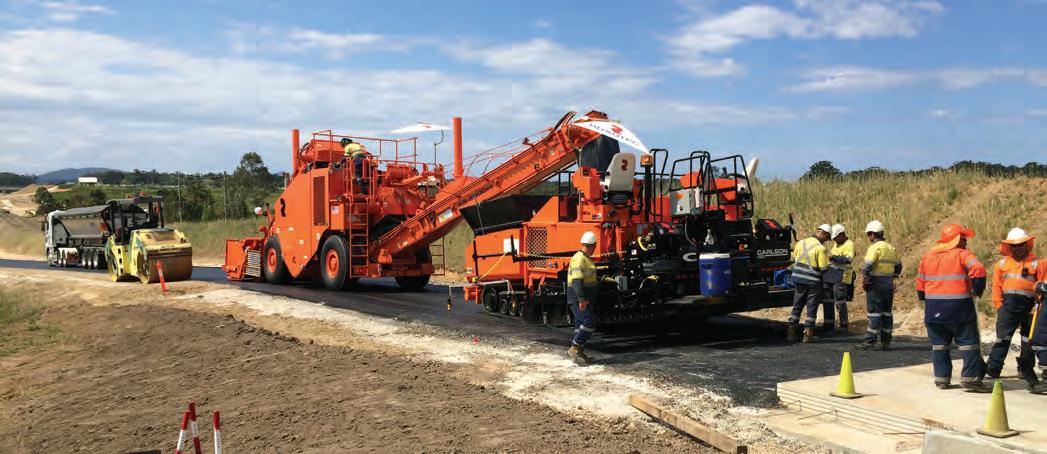
4 minute read
Australian recycled product
GOING GREEN WITH
GEOSYNTHETICS
MANUFACTURER GEOFABRICS IN ALBURY, NEW SOUTH WALES, IS RECYCLING PLASTIC BOTTLES INTO GEOTEXTILE MATERIALS FOR USE WITHIN MAJOR INFRASTRUCTURE PROJECTS TO AID WITH ANYTHING FROM SEPARATION, FILTRATION, DRAINAGE AND CUSHIONING.
Geofabrics turns Australian waste plastic into a viable and beneficial geotextile for road construction through its on-shore manufacturing facilities.
For over 40 years Geofabrics has been providing the infrastructure sector with tailored geotextile solutions. It all began in the 1970’s when the ‘to-be’ owners of Geofabrics came across geotextiles being used for road construction in Europe.
In 1978, Geofabrics got its start in Melbourne and expanded quickly across the country. There are now two Geofabrics manufacturing sites in Australia, one in NSW and one in Queensland.
The Albury factory in NSW is home to all of the company’s road construction industry geotextiles. While Geofabrics has a wide range of different products for road construction, its newest fabric made with recycled plastic is bidim Green.
Bidim Green is made from Australian recyclable materials and Peter Tzelepis, Executive Director of Sales and Business Development at Geofabrics says it can be applied across nearly every civil engineering construction project.
The fabric can be used in the road base to provide separation and filtration under road construction materials such as asphalt.
“The idea for bidim Green came from the issues around circular economy and waste. One of our key sectors for Geofabrics is waste management services and over the last two to three years we have seen this issue develop and we know there is a real need to do something with our waste plastic,” Mr. Tzelepis says.
“Our vision, was that our product will go into the ground to serve a purpose, it’s not going into a landfill. We simply saw it as a great opportunity to support the circular economy.”
Bidim Green is placed underneath the road formation.
Locally made and sourced materials, such as the recycled plastic, are an important factor in the manufacturing process for all Geofabrics products. The company has a specific technical department and innovation sector that works with Australian companies to provide solutions tailored to local conditions.
“Australian conditions are quite unique, from isolation to UV exposure, even rock sizes in road construction can vary in different parts of the country and there might not always be a quarry nearby to provide materials for every road,” Mr. Tzelepis says.
“Geofabrics and its products like bidim Green, which is placed underneath the road formation, are there to reduce the amount of excavation and virgin materials needed on these major infrastructure projects.”
Mr. Tzelepis says bidim Green can also be used when rehabilitating the road surface. He says for example, if a project planned to mill out 100 millimetres of the road surface and replace that asphalt, incorporating a geosynthetic for reinforcement could reduce the amount of asphalt needed by around 40 per cent.
“Another uniquely Australian challenge is the UV exposure. When looking at a UV radiation map of Australia different places have varied exposure to UV which can degrade a geotextile if left exposed for a period of time,” he says.
“To ensure we can provide the right solution we have real time testing on bidim Green at our offices all over Australia to see how it performs with different exposure. We are building the performance of our product to the climatic and environmental changes in different Australian regions.”
Chip sealing is another application, popular in rural Australia, in which bidim Green can be applied to provide improved performance.
“Typically, roads with a chip seal are low volume roads and so when it comes time to repair the pavement, milling out the material
Locally made and sourced materials, such as recycled plastic, are an important factor in the manufacuring process for all Geofabrics products.

and relaying the surface can be costly,” Mr. Tzelepis says.
Bidim Green paving fabric is laid in between two layers of bitumen with the aggregate spread on top, to help provide structure to a fatigued pavement and support the new chip seal.
“It creates a tension membrane, so vehicle loading that may push the road to deform is absorbed by the fabric. The fabric will also absorb the bitumen to create a waterproofing membrane to prevent water from penetrating into the subgrade and affecting moisture content with expansive clays.”
Geofabrics are currently working through a process with the Infrastructure Sustainability Council of Australia to certify bidim Green, to facilitate wider use on Australia’s infrastructure projects.
With demand from governments to use recycled products in infrastructure projects, such as Victoria’s Recycled First program and NSW’s Waste and Recycling Infrastructure Fund, Mr. Tzelepis says bidim Green is another product contractors can consider to make their projects environmentally friendly.
“We know we have to make our materials sustainable, I take my recycling bin out to the kerb every second week, if I know my recycling is going to be picked up and used on projects like my road, that is fantastic.”
PLANT EQUIPMENT PARTS SERVICE & SUPPORT













